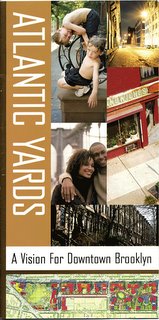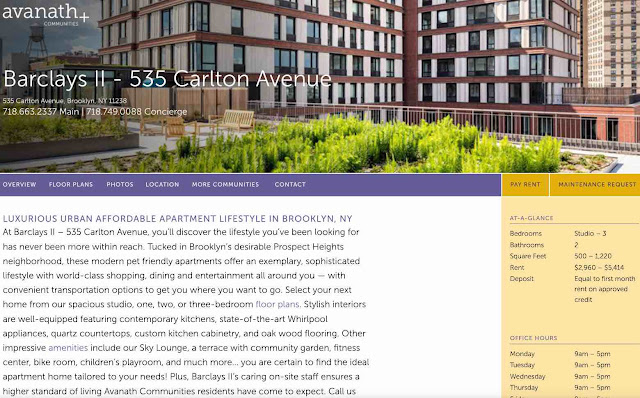Where are Atlantic Yards/Pacific Park towers located? Today, promotional copy (mostly) says Prospect Heights. But the Downtown Brooklyn Partnership still claims them.
That's changed, mostly, likely because the developers and operators recognize reality--mostly--as well the evolving relationship between Atlantic Yards/Pacific Park and the neighborhoods it abuts.
The Downtown Brooklyn strategy
As of the project's announcement in December 2003 and for maybe the next half-decade, there was some strategy to contending that the project was an extension of Downtown Brooklyn.
After all, this border zone in Prospect Heights, near--or in one case replacing some--row houses, couldn't be seen as a natural extension of that generally low-rise neighborhood, or neighboring Fort Greene, Clinton Hill, or Boreum Hill. (That said, across broad Atlantic Avenue, on the north side, there are some high-rises.)
After, only Downtown Brooklyn already had high-rises, albeit in clusters at MetroTech and along Court Street, plus the outlier Williamsburgh Savings Bank tower just north of Atlantic Terminal, which in 2004 spouted its own office tower. The bank building was generally considered one of the southeast poles of Downtown Brooklyn.
 |
| AY site 2008, looking NE, photo Jonathan Barkey |
That, however, was an impossibility, even in a best-case scenario of a ten-year buildout, rather than, as now seems more likely, one lasting at least 25 years after the project's second approval in 2009.
The 2006 Final Environmental Impact Statement (FEIS), produced by Empire State Development Corporation (now Empire State Development). called the project site "adjacent to Downtown Brooklyn."
It also suggested that the "commercial office and residential uses in Building 1" (the unbuilt tower once slated to loom over the arena) and "on Site 5" (the parcel catercorner to the arena, long occupied by big-box stores Modell's and P.C. Richard, once slated for a 250-foot tower, now potentially much more) "would act as an extension of the Downtown Brooklyn central business district."
Arguably, the arena serves as a borderland between Downtown Brooklyn and neighborhood Brooklyn. The rear of the arena block surely backs into Prospect Heights. That said, the Atlantic Yards site, crucially, emerged from a state override of zoning, not the city's Downtown Brooklyn rezoning.
The Downtown Brooklyn rezoning
 |
| Downtown Brooklyn Partnership, 2022 |
Hence, a pivot for Atlantic Yards to Pacific Park, a claim of a new neighborhood, and then a claimed affinity--at least with some of the buildings--with the established nearby neighborhoods.
Yet the Downtown Brooklyn Partnership, ever willing to extend the notion of "Downtown Brooklyn" well beyond the boundaries of any rezoning study, real-estate article, or rough common sense, still claims Pacific Park within its ambit, as shown in the current map, above right, and a 2008 map, below right.
 |
| Downtown Brooklyn Partnership, 2008 |
Now Pacific Park
When the project was renamed Pacific Park in 2014, after Greenland USA took majority ownership from Forest City, the developers focused on positioning the irregular 22-acre site as a new neighborhood. That wasn't entirely new, but it was a new emphasis, especially the distance from Downtown.
From the August 2014 web site, produced by Greenland, which omitted Downtown Brooklyn:
Pacific Park Brooklyn is the largest development at the center of New York City’s hottest Borough. Anchored by Barclays Center, the project will weave 8 million square feet of mixed use development across a 22 acre site and into the surrounding neighborhoods. Upon completion, the project will include an 8 acre public park, 247,000 square feet of retail, 336,000 square feet of commercial space and 6,430 units of housing, 2,250 of which will be affordable for low, moderate, and middle income families. Situated in the intersection of the thriving Fort Greene, Clinton Hill, Boerum Hill, Park Slope and Prospect Heights neighborhoods.
Putting aside the grammar of that last sentence fragment, the "in the intersection" logic didn't make sense--maybe "near" might have worked. Moreover, the development proceeded in two clusters: around the arena block, west of Sixth Avenue, and then one long block away, east of Carlton Avenue. That's no neighborhood.
That said, even as late as January 2018, when Greenland and Forest City restructured their relationship, leaving the latter with just 5% going forward, the official press release, from Forest City (perhaps reliant on previous rhetoric), described the project as "the redevelopment of 22 acres in downtown Brooklyn."
New identities
Today, with five separate owner/operators of residential buildings (not counting the arena), they're free to go their own way, with most of the buildings identifying their location as Prospect Heights and some emphasizing their adjacency to the tree-lined streets of Brownstone Brooklyn--the very zones that contrasted with "Downtown Brooklyn" (and supplied much of the opposition to the project).
Part of that, of course, may be the lack of progress on the privately operated, publicly accessible open space of "Pacific Park," which depends mostly on the decking of two railyard blocks, which hasn't started. And those new developers are not wedded to the marketing of the project as a whole.
Oddly enough, one out-of-state owner identifies two disparate buildings as "Barclays I" and "Barclays II," not recognizing--or recognizing the importance of--the distance between the latter building (B14), at Carlton and Vanderbilt avenues, and the arena.
Pacific Park web site, 2015
The text was vague about neighborhood affinity, though it's notable that the project site is positioned off-center, to the west of the image, thus allowing for the inclusion of neighborhoods to the east like Clinton Hill (and even Bedford-Stuyvesant, though it's not named) and Crown Heights, while ignoring all but a small slice of nearby Downtown Brooklyn (not named):
Just minutes from Manhattan, Brooklyn has become the most desirable borough to call home. Living in Pacific Park, you’ll have prime access to many of the city’s greatest cultural attractions, best restaurants and shopping, and recreational pastimes. And Pacific Park is connected: Twelve subway lines, the Long Island Railroad, service from sixteen bus lines, multiple roadways, and access to ferries on the Brooklyn waterfront are all within walking distance.
Pacific Park web site, 2016
Again, the emphasis on a neighborhood:
Welcome to Pacific Park, Brooklyn’s next great neighborhood. Conceived by the world-renowned architect Frank Gehry, Pacific Park offers all New Yorkers the chance to live in a brand new community at the heart of everything that makes Brooklyn great.
At the center of Pacific Park is a new park designed by landscape architect Thomas Balsley. Stretching across two city blocks, this 8-acre park has something for everyone—sloping lawns for picnics and sunbathing, a public promenade, children’s play areas, a dog run, and athletic spaces—right at the nexus of Brooklyn’s most vibrant neighborhoods.
There’s a new center of it all in Brooklyn. Situated between Fort Greene, Boerum Hill, Clinton Hill, Prospect Heights, and Park Slope, Pacific Park Brooklyn links “old Brooklyn” to “new Brooklyn,” connecting everyone in between.
461 Dean, 2016
The first tower to rise, built solely by Forest City, was 461 Dean, the project's only modular building. Forest City's 461 Dean web site, 2016, lacked a geographic identifier, but emphasized the overall project:
At the nexus of Brooklyn's most vibrant neighborhoods is Pacific Park, Brooklyn. With beautiful residences, designed by leading architects, a brand new 8 acre park, Barclays Center and dynamic neighborhood shopping and dining right in your backyard, Pacific Park has some thing for everyone.
Positioned next to the Barclays Center at the meeting point of vibrant Fort Greene, Downtown Brooklyn, and Prospect Heights neighborhoods, 461 Dean is the perfect spot for anyone looking for the Brooklyn lifestyle
 .
.461 Dean Street offers an unrivaled residential experience with spacious layouts and near limitless views of Brooklyn, Manhattan, and Queens. Being built adjacent to 11 subway lines, the ease of getting around the city is incomparable.535 Carlton, 2017
As far as I can tell, the original website for 535 Carlton Ave., the first of the two "100% affordable" buildings built by the Greenland Forest City Partners joint venture, is still live, claiming:
NEW RENT STABILIZED APARTMENTS IN THE HEART OF BROWNSTONE BROOKLYN
At Pacific Park Brooklyn, residents live in an urban oasis with a leafy eight-acre park, while having access to everything that makes New York the greatest city in the world.
At Barclays II – 535 Carlton Avenue, you’ll discover the lifestyle you’ve been looking for has never been more within reach. Tucked in Brooklyn’s desirable Prospect Heights neighborhood, these modern pet friendly apartments offer an exemplary, sophisticated lifestyle with world-class shopping, dining and entertainment all around you — with convenient transportation options to get you where you want to go.
The residences at 535 Carlton are the ideal escape from city life while only steps away from Brooklyn’s best restaurants, museums and shopping. The serenity of the adjacent Pacific Park is woven into the building’s fabric, creating residences that are conscientiously sustainable.
38 Sixth, 2017
The web site for 38 Sixth Avenue, adjacent to 461 Dean and the second of the two "100% affordable" towers, claimed the same array of neighborhoods that the overall Pacific Park site did:
There’s a new center of it all in Brooklyn. Situated between Fort Greene, Boerum Hill, Clinton Hill, Prospect Heights, and Park Slope, Pacific Park Brooklyn links “old Brooklyn” to “new Brooklyn,” connecting everyone in between. Living at 38 Sixth, the third affordable housing rental residential building to open at Pacific Park, will offer residents a vibrant and convenient location with plenty of open spaces to enjoy.
From StreetEasy:
Conveniently situated amidst Brooklyn’s vibrant restaurants, shopping, and transportation in a flourishing park setting, 38 Sixth sets a new standard.
Strolling encouraged. Escape the hustle and bustle to brownstone-lined streets covered in a canopy of century-old trees. 550 Vanderbilt is located at the intersection of five vibrant, historic Brooklyn neighborhoods: Prospect Heights, Fort Greene, Clinton Hill, Park Slope and Boerum Hill — each with an array of restaurants to sample and charming blocks to explore.
It claims of the overall project Pacific Park:
Pacific Park is more than a place; it’s a community, in the best sense of the word. With 8- acres of inviting green space, generous lawns for picnics and sunbathing, a dog run, athletic spaces and more, outdoor living is at your doorstep.From StreetEasy:
550 Vanderbilt is the first residential building to open in Pacific Park Brooklyn, the revolutionary new Frank Gehry designed 22-acre project coming to Prospect Heights.

The original web site, albeit with a crucial error, does capture the crossroads:
Plank Road sits squarely at the intersection between two worlds. On the one side, classic Downtown Brooklyn, with its National Register of Historic Places buildings and tree-lined streets; a preserved neighborhood rich with the flavors of community. On the other, bustling modern, cosmopolitan downtown, with its blend of restaurants, prime shopping outlets and boutiques humming with culture.(Emphasis added)
Designed by Marvel architects, Plank Road is situated on the southeast corner of Sixth Avenue and Pacific Street, between Pacific and Dean Street in Prospect Heights, Brooklyn.
Situated in prime Prospect Heights, you’re minutes from epic culture and culinary fare in every direction, including historic landmarks like the Brooklyn Academy of Music and dynamic new destinations like Barclays Center.I wouldn't call it "prime Prospect Heights," but it is easy to get places.
595 Dean St is a true urban oasis offering brand new studio, 1, and 2-bedroom rentals surrounded by brownstone Brooklyn.Unmentioned: that "urban oasis" might get a little noisy if and when they build the platform over the Vanderbilt Yard, allowing six towers to rise and, ultimately, delivering that promised park.









Comments
Post a Comment